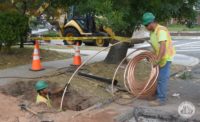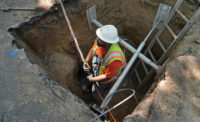The U.S. Environmental Protection Agency says it will issue guidance on how to comply with a Lead and Copper Rule finalized by the Trump administration in 2020. But it will also propose, in coming months, a new rule to speed up lead service line replacements, which critics contend take too long.
The Lead and Copper Rule revision, which went into effect on December 16, remains controversial among both water utilities and environmental and public health advocates. A proposed new rule, to be called the Lead and Copper Improvements Rule, likely would not become final until about 2024.
EPA Administrator Michael Regan said Dec. 16 that President Joe Biden’s January executive order requiring a review of regulations finalized late in the previous administration shows that more revisions are needed. “The science on lead is settled—there is no safe level of exposure, and it is time to remove this risk to support thriving people and vibrant communities,” he said.
Biden has stated a goal to replace 100% of the nation’s lead service lines.
The Trump-era rule strengthens some requirements of the 1991 Lead and Copper Rule but does not go nearly far enough for some, and for others, creates confusion about when utilities are required to take action. Critics add that the decades-long timelines to replace lead service-lines permitted under the 2020 rule will only result in more harm to children and vulnerable communities such as Flint, Mich.; Chicago; and Newark, N.J.
Plan to Reduce Lead
The Biden administration on Dec. 16 also made public a comprehensive administration-wide plan to address lead contamination in drinking water and in paint. It outlines the funding available through the bipartisan Infrastructure Investment and Jobs Act recently signed into law, as well as potential funding in the Build Back Better bill, which currently is stalled in the U.S. Senate.
The administration plan commits to releasing national program guidance in the first quarter of 2022 to help states, communities and tribes access funding for lead-service lines that is available through the new infrastructure law. Additionally, the Office of Management and Budget will issue guidance to help agencies leverage existing funding and ensure that 40% of funding goes to disadvantaged communities.
The U.S. Dept. of Housing and Urban Development also announced award of $13.2 million to state and local government agencies through its Lead-Based Paint Hazard reduction, which identifies and pays for cleanups of lead-based paint in low-income households.
EPA plans to outline new requirements in the Lead and Copper Improvements proposed rule to speed up service-line replacements, which environmental and public health advocates say are advancing at a snail’s pace. EPA’s proposal would also strengthen the way utilities collect tap water samples and attempt to reduce confusion about what actions are needed to address the presence of lead in drinking water systems.
Gains from Guidance
While water utilities commended the administration’s commitment to removing all U.S. lead-service lines, particularly in low-income communities, they also noted challenges in doing that.
David LaFrance, CEO of the American Water Works Association, said in a statement that the requirement under the 2020-revised rule for utilities to develop inventories of all lead service lines “will help communities understand the scope of the challenge and accelerate lead service line replacement.” He added that replacing lead service lines is a “tremendous and necessary undertaking” that many utilities are already making real progress in addressing.
Michael Drysdale, an attorney with law firm Dorsey & Whitney, notes a “broad consensus” that removal of lead pipes is worthwhile. There is no significant "pro-lead-pipe" constituency, he says, but key issues that could be contentious during development of the new regulation include the schedule by which pipes must be removed, and the availability of federal funding.
“Although the recently enacted infrastructure package provided $15 billion in funding for lead pipe removal, another approximately $30 billion to $45 billion is needed. The administration has not signaled to date its anticipated replacement schedule or funding support,” he says.
Erik Olson, senior strategic director of health at the Natural Resources Defense Council, blasted EPA’s decision to allow the Trump-era rule to go into effect at all. The group estimates that as many as 12 million lead pipes are currently delivering tainted drinking water across the U.S., particularly in low-income neighborhoods. “It’s clear the Biden administration hopes to overhaul this fundamentally flawed rule and to make urgently needed fixes,” Olson said. “But based on past performance, there is a risk that EPA will not get around to fully and promptly overhauling and strengthening it.”





Post a comment to this article
Report Abusive Comment